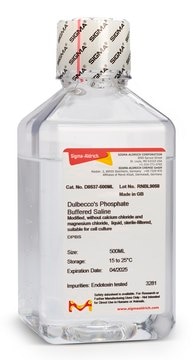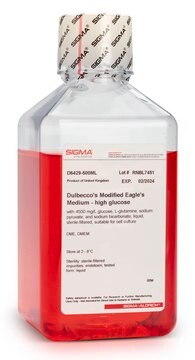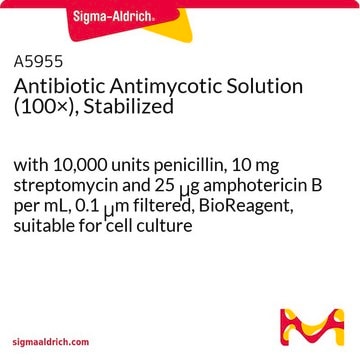T4174
Trypsin-EDTA solution
10 ×, sterile-filtered, BioReagent, suitable for cell culture, 5.0 g porcine trypsin and 2 g EDTA, 4Na per liter of 0.9% sodium chloride
Synonym(s):
Cocoonase, Tryptar, Tryptase
About This Item
Recommended Products
biological source
Porcine
Quality Level
sterility
sterile-filtered
product line
BioReagent
form
solution
mol wt
23.4 kDa
concentration
10 ×
technique(s)
cell culture | mammalian: suitable
impurities
Porcine parvovirus, none detected (9 CFR)
pH
7.0-7.6
shipped in
dry ice
storage temp.
−20°C
Looking for similar products? Visit Product Comparison Guide
Application
Trypsin-EDTA solution is used for the following applications:
- Used as a supplement in cell culture for their maintenance
- In harvesting cells grown to confluence
- to detach lentivirus-transduced macrophages
Biochem/physiol Actions
Serine protease inhibitors, including DFP, TLCK, APMSF, AEBSEF, and aprotinin, amongst others, will inhibit Trypsin.
Components
Caution
Preparation Note
also commonly purchased with this product
recommended
Storage Class
12 - Non Combustible Liquids
wgk_germany
WGK 1
flash_point_f
Not applicable
flash_point_c
Not applicable
Choose from one of the most recent versions:
Certificates of Analysis (COA)
Don't see the Right Version?
If you require a particular version, you can look up a specific certificate by the Lot or Batch number.
Already Own This Product?
Find documentation for the products that you have recently purchased in the Document Library.
Customers Also Viewed
Protocols
Trypsin is commonly used for dissociating adherent cells from surfaces. A wide variety of trypsin solutions are available to meet your specific cell line requirements.
Our team of scientists has experience in all areas of research including Life Science, Material Science, Chemical Synthesis, Chromatography, Analytical and many others.
Contact Technical Service







